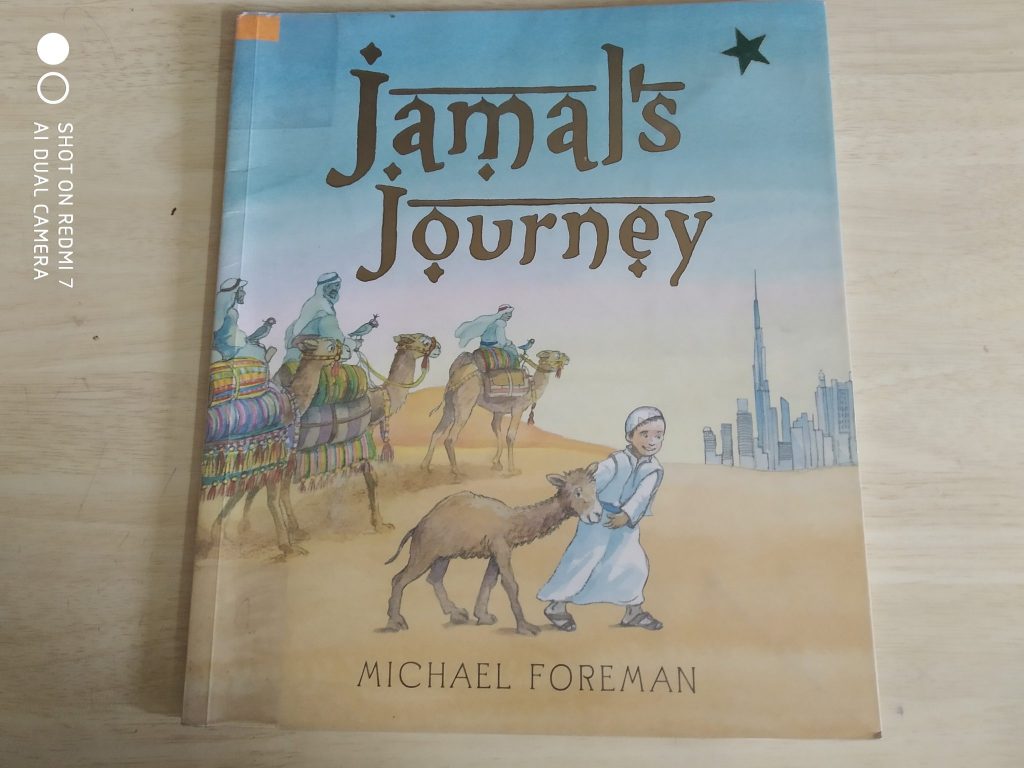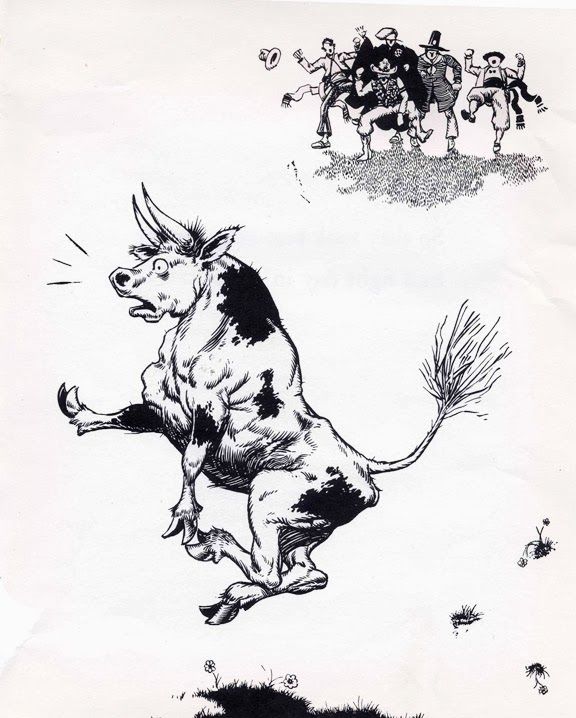“What kind of books should we select for Read Alouds at MOP Chimbel?” was my question in a conversation with our Director, Sujata Noronha at the start of October. The response was in the form of another question, “what trends are you observing in the children visiting the library in the last few sessions?” This made me think back to the children recently visiting the library, who were mostly new to the library. There being mixed age groups, the stories had to be not too basic or too advanced in comprehension levels. Also we felt the stories had to be light and humorous so as not to be overwhelming in the form of serious discussions or lengthy texts. The answer was clearer and the challenge of selecting the texts was narrowed down to lighter stories of medium length, which had an element of humor that the children could like and follow easily. Here is a sharing on some of the Read Aloud sessions, which resulted from this discussion on selection of stories.
‘Jamal’s Journey’ by Michael Foreman
The setting of the book in a desert, connected with some of the children who had attended a Read Aloud of ‘The Day of Ahmed’s Secret’ by Florence Parry Heide (Author), Judith Heide Gilliland (Author), Ted Lewin (Illustrator), from a session in the previous month. A soft toy of a camel was taken, which was introduced to the children as ‘Jamal’, the main character of the story. The children love it when we take a soft toy and were keen to hold ‘Jamal’ in their arms, in turns, after the story was over. The story is about a young camel’s adventure, which gets separated from his parents in a caravan because of a desert storm. This allowed children to think about how Jamal would make it through the desert. Most of the children were quite sure he would make it through, some way or another. This story brought to their minds journeys of their own. Sahil and Aliya shared about their train journeys to Mumbai. Like the animals in the story, Arfan remembered peacock’s and monkeys, that he saw on his way to his native place in Karnataka. While connecting with Jamal’s problem in the story, Nisbah was reminded of a scary looking man she saw, before boarding a train to Hubli.
‘Rock-a-Doodle-Do!’ by Michael Foreman
This story allowed us to think about our dreams for our future, while sharing in this comic adventure of a donkey, a rooster, a cat and a dog, that set off to fulfill their dreams of being musicians. At the start of the story we shared a set of dream cards for each of the children to pick from, which gave them a clue about what they needed to do to achieve their creative dreams. The magic in these cards, got the children latched on to the topic, as they found their cards giving useful pointers, which they were keen to read and find out about. An interactive element that kept children engaged with this story, was making the animal sounds and actions, as the characters appeared in the story. They thoroughly enjoyed the comedy brought out by this wonderful author, while the animals in the story have to fight off a gang of robbers, as they stumble on a way to fulfill their dream in the form of an abandoned cafe. In the extension activity, Arzoo got to think and write about her own dream of becoming a doctor and how she and her friend had felt motivated by this cause. Salman, Arsh and Arfan liked to sing and connected well with the characters in the story, as they sang a few songs for us as part of the extension activity.
‘The Story of Ferdinand’ written by Munro Leaf and illustrated by Robert Lawson
Selecting this all time favorite story was an easy choice and was sure to be loved by the children. This is a story about a bull that unlike what one would expect a bull to be (angry, unapproachable and keen to fight), is very gentle and loves the fragrance of flowers and sitting silently under a cork tree. The funny scenes in the story had the children laughing heartily. Like where Ferdinand is selected for a bull fight because it is felt he is the strongest, after he displays great strength and power, unintentionally, only because of the pain of a bee stinging his bottom when he sits on a flower bed. Another such scene captures the frustration of the Matador because Ferdinand refuses to charge at him and instead sits down to smell the flowers in the hair of women, carried to him by the breeze blowing from the audience. The children also had a chance to experience Ferdinand’s preference for the fragrance of flowers, as one of the children shared a few flowers from those she had tied in her hair, with the children, as we all experienced their fragrance like Ferdinand. In the extension activity we tried to find an easy way to draw Ferdinand as a symbol of might and gentleness.
Ferdinand is stung by a bee.
‘The Secret Message’ based on a poem by Rumi, written by Mina Javaherbin and illustrated by Bruce Whatley
This is a story of a very colorful parrot in the cage of a wealthy merchant, who longs to fly free in the jungles like its friends. While the merchant feels the bird should be more than content in a golden cage with three swings. A new settling down activity that was tried for this story worked well before and after the story, where the children had to make bird actions of ‘open your wings-close your wings- fly away- sit down there’. The children loved these actions and it was found to be a useful way of drawing them back to attention, even later at a point in the extension activity where the group was getting unsettled. During the story we had our Resource Person Jewel, Volunteer Radhika and Library Assistant Muskan, to act out as the parrots in the story, from a scene where the merchant delivers his parrot’s message, to the parrots in the jungle. This performance element developed from a previous Read Aloud for a senior citizens group at Bookworm, was very useful in bringing the Read Aloud to life, as the children thoroughly enjoyed the surprise of three ‘live’ parrots joining them in the middle of the Read Aloud. The book held the ‘secret message’ very well and came as a surprise to the children who least expected the story to end the way it did. Learning from these birds in the story, we discussed problems that we were having, in the group as we recognized that most often, others can help us figure out solutions to the problems that we cannot work out alone.
Discussion activity after ‘The Secret Message’
From this experience, I learnt that in selecting books to Read Aloud to children, cues from the audience are most important. Like indications of interest from the children, age groups and comprehension abilities, besides having to step into their shoes before deciding what kind of stories they might like. Also one has to keep in mind their responses and feedback once the story is read, as clues for future sessions. Often the story tends to be conveyed only by expressions of the reader, the text and illustrations in the books. So interactive elements like soft toys, performing a scene from the story, story specific settling down activities or games and samples of key elements of the story (like flowers for Ferdinand’s story) can help in adding a third dimension and bring a story to life within the Read Aloud space.




